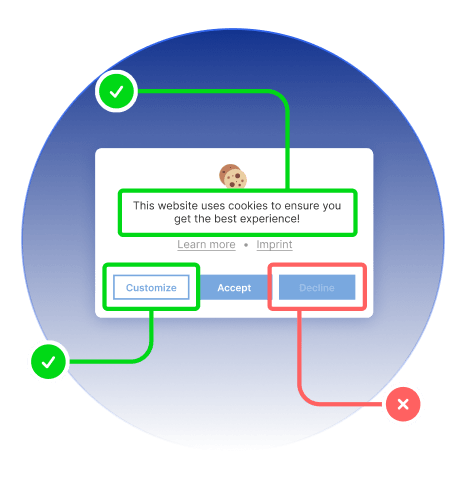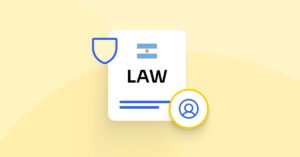Introduction
Implementing robust cookie consent practices is essential for website owners. Cookie consent banners serve as the initial point of contact between the website and its visitors, informing users about data collection practices and setting the stage for compliance with privacy laws such as the General Data Protection Regulation (GDPR) and the California Consumer Privacy Act (CCPA).
Ensuring a seamless user experience begins with the proper introduction of cookie consent banners. These banners should be placed strategically on the website to capture the user’s attention and obtain cookie consent without disrupting interaction. From the moment users land on a site, they should be aware of the website’s data collection practices and the purpose of cookies.
Understanding the legal landscape
Navigating the legal landscape is crucial for website owners seeking to comply with privacy regulations. The GDPR and CCPA, two prominent regulations, emphasize how important it is to obtain explicit consent before storing or accessing cookies on a user’s device. Websites must be familiar with the specific requirements outlined in these regulations to avoid legal repercussions and safeguard user privacy.
To meet the stringent standards set by these regulations, cookie consent banners should be designed to provide clear and concise information about the types of cookies used, the purpose of data collection, and how users can opt-out of particular categories of cookies or manage their consent preferences. This understanding forms the foundation for building a robust and legally compliant cookie consent mechanism.
Cookie consent banners and their role
Cookie consent banners are pivotal in fostering transparency between websites and users. These banners serve as the first point of contact, informing users about the website’s data collection practices and obtaining their consent for using cookies. The design and content of cookie consent banners are critical, as they influence the user’s perception of the website’s commitment to privacy.
An effective cookie consent banner should be prominently displayed and use language easy for users to comprehend. It should inform users about the presence of cookies and provide options for users to accept or reject them. Additionally, the cookie notice banner should include a link to the website’s comprehensive privacy policy for users who wish to delve deeper into the details of data processing practices.
Implementing GDPR-compliant cookie banners
For websites operating within the European Union or targeting EU citizens, compliance with the GDPR is non-negotiable. Cookie banners must be designed to align with the GDPR’s transparency and user control principles. This entails explicitly informing users about the purpose of data collection, the types of cookies used, and obtaining their explicit consent before any non-essential cookies are stored on their devices.
To achieve GDPR compliance, cookie banners should be configured to allow users to make granular choices about the types of cookies they are willing to accept. Additionally, the mechanism for obtaining consent should be user-friendly, ensuring that users can easily navigate the options and provide explicit consent.

Explicit consent and its importance
Obtaining explicit consent is a cornerstone of privacy regulations worldwide. Cookie consent banners should not only serve as a passive notification but should actively require users to provide explicit consent. This means that users must take a clear and affirmative action, such as clicking an “Accept” button, to signify their agreement to use cookies.
Explicit consent is particularly crucial regarding third-party cookies involving external entities accessing user data. Cookie banners should clearly communicate the presence of third-party cookies and provide users with the information they need to make an informed decision about granting consent.
Types of cookies and consent
Distinguishing between first-party and third-party cookies is essential for effective cookie consent management. First-party cookies are those set by the website being visited, while external domains set third-party cookies. While using first-party cookies may not require explicit consent, the same cannot be said for third-party cookies.
To meet legal requirements, cookie consent banners should differentiate between these types of cookies, providing users with specific information about each. This transparency allows users to make informed decisions based on the nature of the cookies and the entities involved in data processing.
The role of Consent Management Platforms
Consent Management Platforms (CMPs) have emerged as valuable tools for website owners seeking to streamline obtaining and managing user consent. These platforms offer a centralized solution for implementing and customizing website cookie consent banners.
CMPs enable website owners to stay agile despite evolving privacy regulations. By utilizing a consent management platform, website owners can easily update their cookie consent mechanisms to align with changes in the legal landscape. This adaptability ensures continuous compliance and enhances the overall user experience.
Withdraw consent
Respecting user autonomy is a fundamental aspect of privacy compliance. Cookie consent is not a one-time transaction; users must be allowed to withdraw their consent at any time. Cookie banners should include clear instructions on how users can manage their consent preferences, including the ability to revoke consent previously given.
The process of withdrawing consent should be as straightforward as providing it initially. Websites should offer users the option to easily navigate their privacy settings or cookie preferences, allowing them to adjust based on their evolving comfort levels with data collection practices.
The significance of user privacy
User privacy should be at the forefront of every website owner’s approach to cookie consent. Cookie banners should be designed with the user’s privacy in mind, emphasizing transparency, user control, and clear communication about data processing practices.
To enhance user privacy, cookie consent banners can include educational elements that explain the benefits of cookies and how they enhance the user experience. This educational approach can contribute to a more positive perception of data collection practices and foster a sense of trust between the website and its users.

Specifics of Google Analytics and cookie consent
For websites utilizing Google Analytics, compliance involves obtaining valid consent from users for using analytics cookies. Google Analytics collects and processes data related to user behavior on a website, making it subject to privacy regulations.
Website owners should ensure that their cookie consent banners explicitly address using Google Analytics cookies. This includes informing users about the purpose of these cookies and obtaining their explicit consent before any data is collected. Google Consent Mode is a tool that can be employed to align with Google’s guidelines and privacy regulations when implementing cookie consent for analytics.
Cookie banner templates
Creating an effective cookie banner involves a combination of design and content. Cookie banner templates offer a starting point for website owners, providing a framework that can be customized to meet specific branding and compliance requirements.
When selecting or designing a cookie banner template, it’s crucial to consider the visual appeal, clarity of language, and ease of use. Templates should be adaptable to different types of websites and user interfaces while ensuring that all necessary information is presented concisely and user-friendly.
Cookies require consent across multiple websites
Website owners with multiple online properties must ensure consistent cookie consent practices across all their platforms. This consistency extends to cookie consent banners’ design, language, and functionality. Users interacting with various websites owned by the same entity should encounter uniform information and choices regarding data collection.
A centralized approach to cookie consent, possibly facilitated by a consent management platform, ensures that users receive a standardized experience regardless of the specific website they are visiting. This consistency not only aids in compliance but also contributes to a cohesive brand image.
Opt-in mechanisms for cookie consent
Implementing an opt-in mechanism is a best practice to ensure users actively agree to use cookies. This approach aligns with the principles of explicit consent, requiring users to take a proactive step to indicate their willingness to accept cookies.
Opt-in mechanisms can be incorporated into cookie consent banners by default, prompting users to choose before proceeding further on the website. This ensures that data collection practices are transparent and that users are fully aware of and comfortable with the cookies stored on their devices.
User preferences and cookie consent
Respecting user preferences is integral to building trust and maintaining a positive user experience. Cookie consent banners should allow users to customize their preferences, allowing them to select the types of cookies they are willing to accept or reject.
Offering granular control over cookie preferences enhances user satisfaction. For instance, users may accept essential cookies while rejecting non-essential ones. By empowering users to tailor their cookie settings, websites demonstrate a commitment to user-centric data processing.

Blocking cookies and consent
Some users may block or reject cookies altogether due to privacy concerns or personal preferences. Cookie consent banners should include a clear and easily accessible method for users to decline all cookies. This may involve a prominent “Decline” button or a link to privacy settings where users can make specific choices about cookie preferences.
Respecting users who can block cookies is crucial for maintaining trust. Websites should not penalize users for exercising their right to restrict data collection but instead ensure that the user experience remains functional and informative even without cookies.
Informing visitors about cookie practices
Cookie consent banners serve as a preliminary communication tool, but websites should go further by providing a dedicated cookie policy page. This page is a comprehensive resource, offering detailed information about the types of cookies used, their purposes, and instructions on how users can manage their consent preferences.
A well-crafted cookie policy page enhances transparency and demonstrates a commitment to providing users with the information they need to make informed decisions about their privacy. This page should be easily accessible from the cookie consent banner and other prominent website sections.
The role of the ePrivacy Directive
In addition to adhering to the GDPR, websites must consider the implications of the ePrivacy Directive. This directive specifically addresses electronic communications and places additional requirements on using cookies. Understanding and incorporating the ePrivacy Directive’s provisions into cookie consent practices is essential for comprehensive compliance.
Cookie consent banners should be designed to align with both the GDPR and the ePrivacy Directive, ensuring that users are informed and given choices regarding data collection practices in electronic communications. This dual compliance approach enhances a website’s legal standing and comprehensively protects user privacy.
Prior consent for cookies
The concept of prior consent is foundational to privacy laws. Cookie consent banners should be configured to obtain consent before cookies are stored on a user’s device. This proactive approach ensures that users know and agree to data collection practices before any information is processed.
By prioritizing prior consent, websites demonstrate a commitment to ethical data processing. This approach aligns with transparency and user control principles, fostering a positive relationship between the website and its users.
The European Data Protection Board’s guidelines
The European Data Protection Board (EDPB) issues guidelines that provide valuable insights into the interpretation and implementation of privacy regulations. Staying abreast of the EDPB’s guidelines is crucial for website owners seeking to ensure cookie consent banners meet the requirements set forth by the GDPR and other applicable regulations.
The EDPB’s guidelines may clarify nuanced aspects of cookie consent, helping website owners navigate complex scenarios and make informed decisions. Regularly checking for updates from the EDPB ensures that cookie consent practices remain aligned with the latest interpretations of privacy laws.

User requests and cookie consent
User requests related to cookie consent should be handled with transparency and efficiency. Websites that store cookies should provide users with easy access to information about the data collected through cookies and offer mechanisms for users to exercise their rights under privacy laws.
Users should be empowered to make these requests seamlessly, whether accessing a copy of their data, updating consent preferences, or withdrawing consent altogether. This commitment to user-centric data processing contributes to a positive user experience and builds trust.
Targeted advertising and cookie consent
Obtaining explicit consent for cookies in personalized advertising is paramount for websites engaged in targeted advertising. Cookie consent banners should clearly communicate the connection between data collection and targeted advertising, ensuring that users are fully aware of the implications of their consent.
In addition to obtaining consent, websites should provide information about the types of personal data collected for targeted advertising purposes. Transparency allows users to make informed decisions based on their comfort levels with personalized advertising.
Free cookie banners and their limitations
While free cookie banner solutions are available, website owners should exercise caution. Some free options may lack the customization and features needed for comprehensive compliance with privacy laws. Investing in a robust and reputable cookie consent manager or platform may be necessary to ensure all legal requirements are met.
Free cookie banners might have limitations, such as a lack of flexibility in design, limited features for obtaining and managing consent, or potential privacy concerns. Website owners should carefully assess their needs and consider the long-term implications of using free solutions for cookie consent management.
Implementing cookie consent for user’s language preferences
User experience is enhanced when cookie consent banners are presented in the user’s preferred language. Websites should consider implementing language preference settings to ensure users can fully understand the information provided in the cookie consent banner.
Addressing language preferences is a thoughtful approach to user experience, especially for websites with a diverse audience. Language options should be easily accessible and prominently featured in the cookie consent banner, allowing users to choose the language that best suits their understanding.
Ensuring accessibility of cookie consent banners
Accessibility is a critical consideration in the design of cookie consent banners. Websites should ensure their cookie consent mechanisms are accessible to all users, including those with disabilities. This includes providing alternative text for images, ensuring compatibility with screen readers, and offering keyboard navigation options.
By prioritizing accessibility, websites demonstrate a commitment to inclusivity and ethical data processing. Users with disabilities should have an equal opportunity to understand and manage their consent preferences, fostering a digital environment that is accessible to everyone.
Conclusion
To ensure that cookie consent banners comply with legal requirements, website owners must take a multifaceted approach involving various aspects. First and foremost, transparency should be prioritized. This means that users should be informed about the types of cookies used on the website and how they will affect their browsing experience. Secondly, website owners should provide users with adequate control over their cookies. Users should be able to choose which cookies they allow and which they do not, which should be clear in the consent banner.
Finally, website owners should strive to maintain continuous compliance with privacy regulations. This means staying up-to-date with the latest laws and guidelines and making changes to the cookie consent banner as necessary. By adopting this approach, websites can demonstrate a commitment to user privacy and navigate the complex landscape of cookie consent with confidence and integrity.







